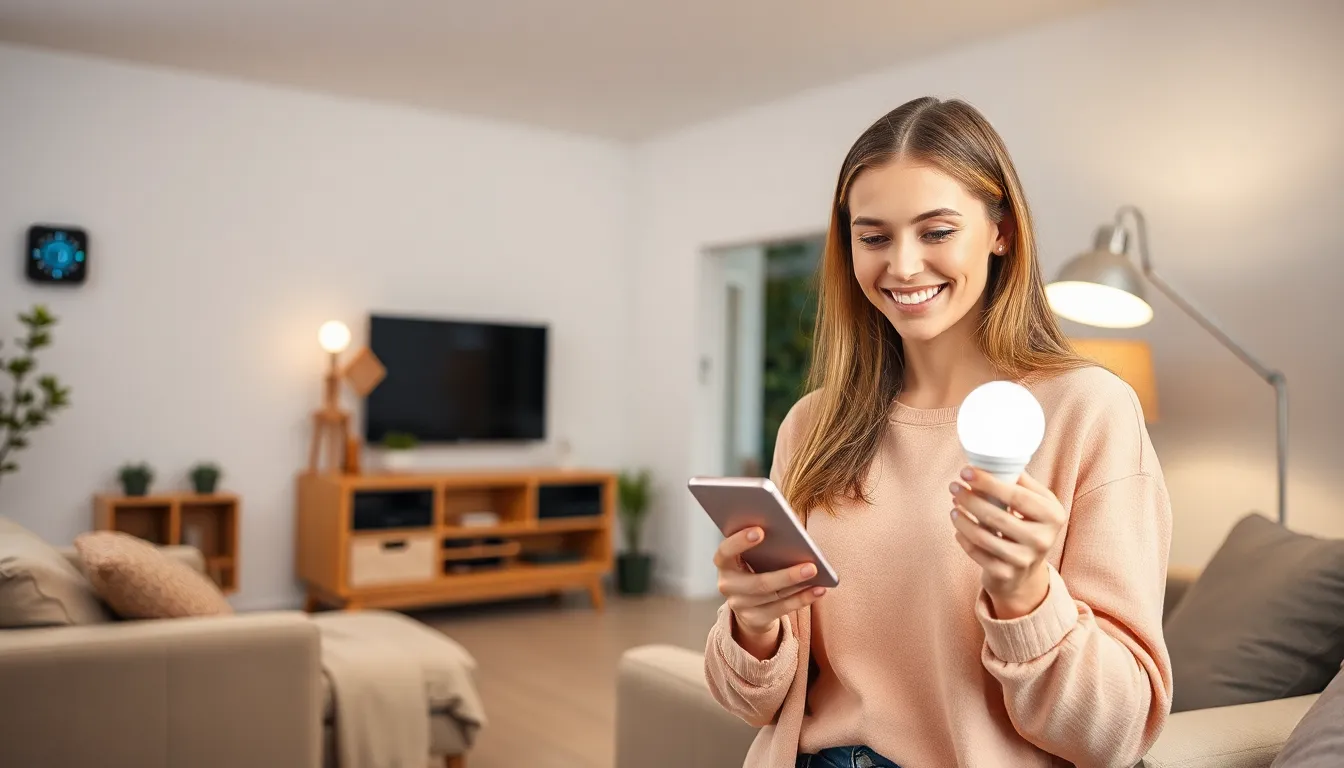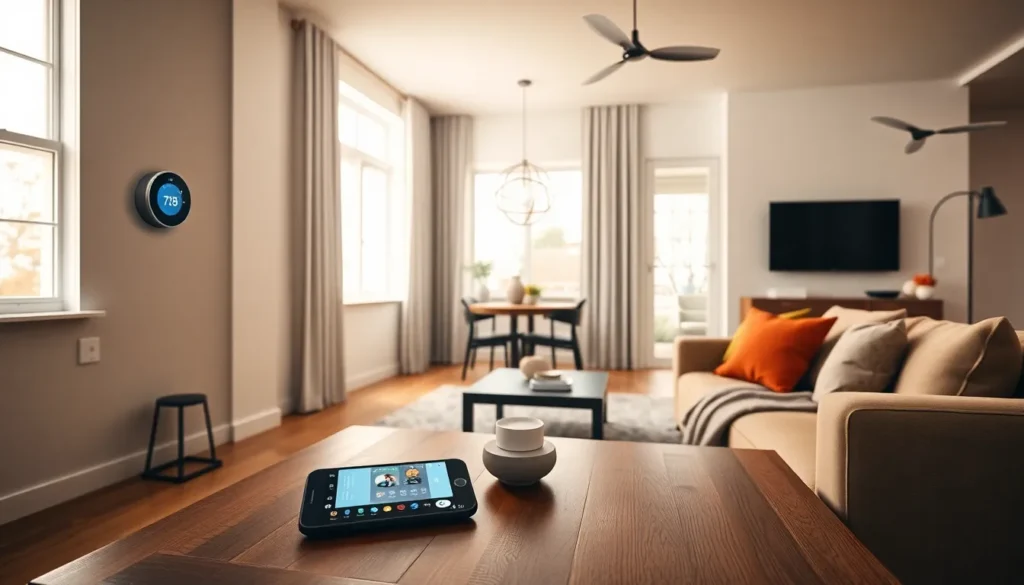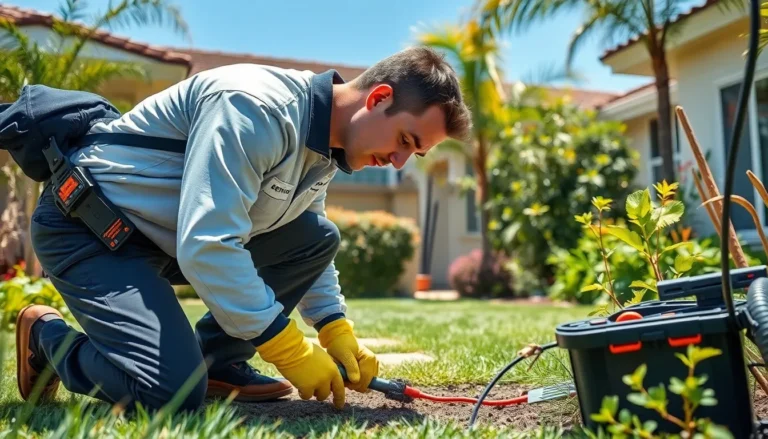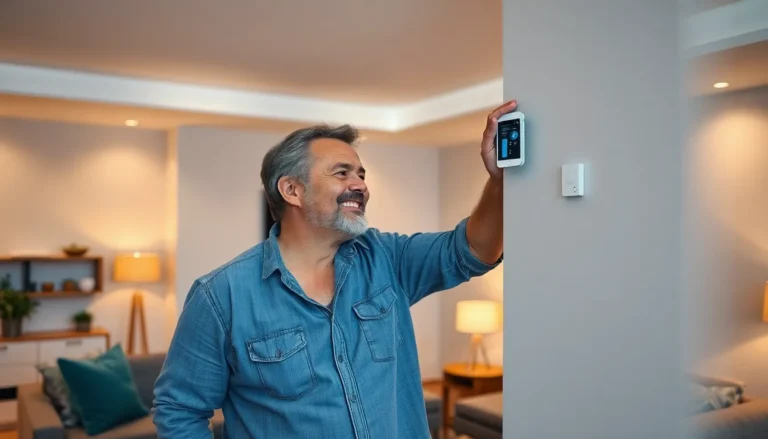Table of Contents
ToggleImagine walking into your home after a long day, and with a simple voice command, the lights dim, your favorite playlist starts, and the thermostat adjusts to the perfect temperature. Sounds like magic, right? Welcome to the world of home automation systems, where technology and convenience collide to make life a whole lot easier.
Overview Of Home Automation Systems
Home automation systems integrate technology to streamline household tasks. These systems allow users to control devices remotely, enhancing comfort and security. Popular components include smart lighting, thermostats, and security cameras. Each device works together, creating a cohesive environment tailored to individual preferences.
Users can manage settings through smartphones or voice commands, making interactions intuitive. For instance, smart speakers can execute commands to adjust lighting or play music. Data from sensors helps automate routines, adjusting temperature based on time of day or occupancy.
Energy efficiency is another key benefit. Smart thermostats optimize heating and cooling, resulting in lower utility bills. Lighting systems can adjust based on natural light levels. These adjustments contribute to sustainable living while also adding convenience.
Security features, such as cameras and alarm systems, provide peace of mind. Homeowners receive alerts on their devices when unusual activity is detected. Remote monitoring allows users to check their properties, enhancing safety.
Flexibility in home automation systems is significant. Individuals can customize setups according to their needs, whether for convenience, security, or energy savings. Many systems are compatible with various products, making upgrades simple.
Integration with voice assistants has revolutionized how homeowners interact with technology. He or she can easily request information or command devices with simple phrases. This hands-free approach adds another layer of convenience to daily routines.
Home automation systems offer numerous advantages, combining comfort, efficiency, and security into one seamless solution.
Key Components Of Home Automation

Home automation systems consist of essential components that enhance functionality and user experience. Each element works together to create a smart home environment.
Smart Devices
Smart devices are the backbone of any home automation system. They include items like smart bulbs, thermostats, and security cameras that connect to a network. Through sensors and smart technology, these devices can communicate and respond to commands. Smart lighting adjusts brightness based on occupancy or natural light. Smart thermostats optimize energy usage, learning user habits for enhanced efficiency. These devices contribute significantly to convenience and energy savings.
Central Hub
Central hubs serve as the control center for home automation systems. They connect various smart devices, enabling seamless communication between them. Hubs allow users to manage devices from different brands in one place. A central hub establishes routines and schedules, enhancing automation. It also facilitates remote access through a smartphone or tablet, ensuring control from anywhere. By eliminating compatibility issues, central hubs simplify the integration of multiple devices.
User Interfaces
User interfaces play a critical role in interaction with the home automation system. They include mobile apps, web portals, and voice assistants that make controlling devices intuitive. Users can easily set preferences, monitor systems, and receive alerts through these interfaces. Voice commands offer hands-free options, promoting ease of use. Customization options allow individuals to tailor controls to their preferences. As a result, user interfaces enhance the overall experience of home automation.
Benefits Of Home Automation Systems
Home automation systems offer several advantages that enhance daily living. These benefits include convenience, energy efficiency, and enhanced security.
Convenience And Comfort
Life becomes easier with home automation systems. These systems allow control of various devices from smartphones or through voice commands. Users can adjust lighting, temperature, and entertainment systems effortlessly. One simple command can create a comfortable atmosphere tailored to personal preferences. Smart devices communicate seamlessly, ensuring that routines are followed without hassle. Automation can schedule actions, such as turning on lights when dusk falls. Comfort increases when homes respond intuitively to occupants’ needs.
Energy Efficiency
Energy efficiency represents a notable advantage of home automation systems. Smart thermostats provide optimal heating and cooling, adapting automatically to user habits. These devices can lower energy bills by ensuring systems operate efficiently. Smart lighting adjusts automatically based on natural light, reducing unnecessary consumption. Users can monitor their energy usage in real-time, aiding in making informed decisions. Sustainability becomes a priority as homes operate in an eco-friendly manner, contributing to a reduced carbon footprint.
Security Enhancements
Security enhancements stand out among the benefits of home automation systems. Smart cameras and alarm systems monitor homes continuously, providing real-time alerts for unusual activities. Homeowners can view live feeds remotely, adding a layer of reassurance. Automation can simulate presence by controlling lights and sounds when away, deterring potential intruders. Integration with security services simplifies emergency responses, allowing for quick action in critical situations. Overall, these systems empower individuals with peace of mind, keeping their homes secure.
Challenges And Considerations
Home automation systems come with challenges that require careful consideration. Cost implications and technical complexity often play significant roles in shaping user decisions.
Cost Implications
Initial investment in a home automation system can vary widely based on device choice and installation requirements. Smart devices typically range from $20 to $300, while complex installations may reach thousands. Ongoing expenses, such as subscription fees for cloud services or security monitoring, add to this financial commitment. Homeowners should also consider potential savings on utility bills through energy-efficient devices. Evaluating long-term benefits against upfront costs is essential for making a sound investment in automation technology.
Technical Complexity
Understanding the technical intricacies of home automation systems proves vital for successful implementation. Many devices require a stable internet connection and compatibility checks with existing hardware. Users might face challenges in setting up networks or integrating devices from different manufacturers. This complexity can deter less tech-savvy individuals from fully utilizing their systems. Comprehensive user manuals or professional installation services can help navigate these hurdles, ensuring enjoyable interactions with automated environments.
Future Of Home Automation
Technological advancements promise a transformative future for home automation. Innovations in artificial intelligence enhance device interconnectivity, making systems smarter and more intuitive. Users can expect increased integration of IoT devices, allowing seamless communication between appliances across different brands.
Predictive analytics will play a crucial role in personalizing user experiences. These systems will analyze habits, suggesting energy-saving settings based on user behavior. As a result, homeowners may benefit from customized recommendations for comfort and efficiency.
Standards for interoperability are also improving. Organizations collaborate to create universal protocols, enabling devices from various manufacturers to work together fluidly. This compatibility should reduce installation complexities and streamline user experiences.
Security will continue to be a focal point in home automation development. Advanced encryption methods will protect devices against hacking, enhancing homeowner trust. Furthermore, AI-powered security systems will detect unusual activity, providing real-time alerts and peace of mind.
Sustainability remains an essential consideration. Future systems will include features that optimize power consumption, contributing to greener living. Smart energy management will not only reduce bills but also support renewable energy sources.
Voice assistant technologies will evolve further, increasing their capabilities in controlling smart devices. These developments will make interacting with home automation systems even more natural and efficient. Convenience remains a top priority for developers, ensuring users can manage homes effortlessly.
Costs may decrease as the technology becomes more mainstream. As competition increases, prices of devices likely will become more accessible, encouraging broader adoption. Overall, the future of home automation systems points toward enhanced convenience, efficiency, and security for users.
Home automation systems represent a significant leap forward in how individuals interact with their living spaces. By seamlessly integrating technology into daily routines, these systems offer unparalleled convenience and security. With the ability to customize experiences and optimize energy consumption, homeowners can create environments that align with their lifestyles.
As technology continues to evolve, the potential for home automation systems grows even more promising. Future advancements in AI and IoT will likely enhance connectivity and user experience, making smart homes more accessible. Embracing these innovations could transform not just how homes function but also how individuals enjoy their everyday lives.







